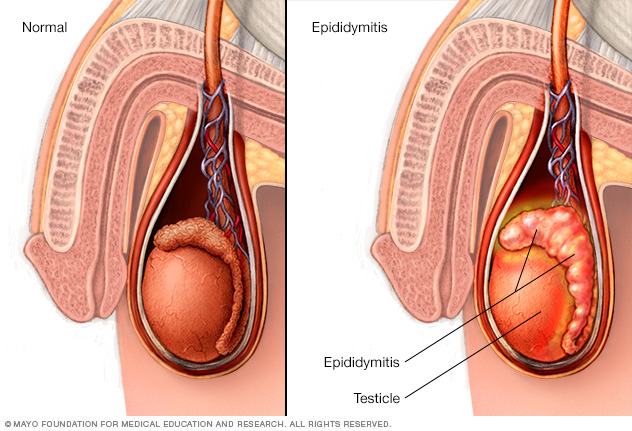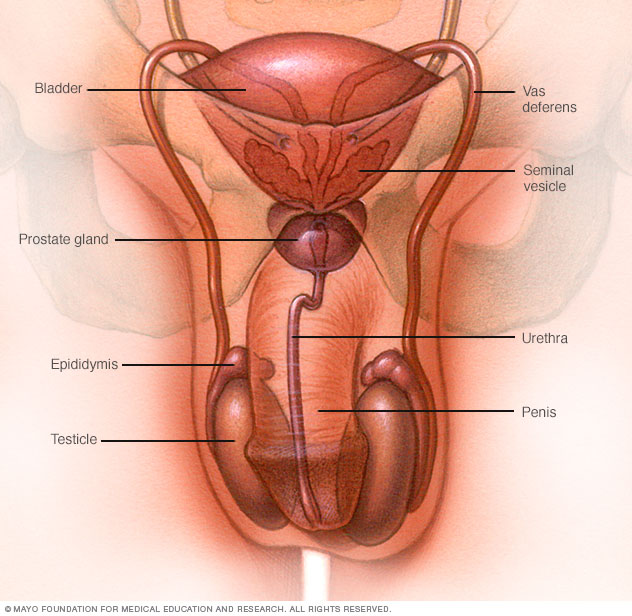Overview
Epididymitis (ep-ih-did-uh-MY-tis) is an inflammation of the coiled tube, called the epididymis, at the back of the testicle. The epididymis stores and carries sperm. Males of any age can get epididymitis.
Epididymitis is most often caused by a bacterial infection, including sexually transmitted infections (STIs), such as gonorrhea or chlamydia. Sometimes, a testicle also becomes inflamed — a condition called epididymo-orchitis.
Epididymitis is usually treated with antibiotics and measures to relieve discomfort.
Symptoms
Symptoms of epididymitis might include:
- A swollen, discolored or warm scrotum
- Testicle pain and tenderness, usually on one side, that often comes on slowly
- Pain when you pass urine
- An urgent or frequent need to urinate
- Discharge from the penis
- Pain or discomfort in the lower abdomen or pelvic area
- Blood in the semen
- Less commonly, fever
Chronic epididymitis
Epididymitis that lasts longer than six weeks or that happens over and over again is considered chronic. Symptoms of chronic epididymitis might come on slowly. Sometimes the cause of chronic epididymitis isn't able to be found.
When to see a doctor
Don't ignore scrotal pain or swelling. This can be caused by a number of conditions. Some of them need treatment right away to avoid permanent damage.
If you have severe pain in the scrotum, seek emergency treatment. If you have discharge from your penis or pain when you pass urine, see a health care provider.

Causes
Causes of epididymitis include:
- STIs. Gonorrhea and chlamydia are the most common causes of epididymitis in young, sexually active males.
- Other infections. Bacteria from a urinary tract or prostate infection might spread from the infected site to the epididymis. Also, viral infections, such as the mumps virus, can result in epididymitis.
- Urine in the epididymis. This condition occurs when urine flows backward into the epididymis, causing chemical irritation. It may be the result of heavy lifting or straining.
- Trauma. A groin injury can cause epididymitis.
- Tuberculosis. Rarely, epididymitis can be caused by tuberculosis infection.

Risk factors
Certain sexual behaviors that can lead to STIs put you at risk of sexually transmitted epididymitis, including having:
- Sex with a partner who has an STI
- Sex without a condom
- Anal sex
- A history of STIs
Risk factors for epididymitis that's not sexually transmitted include:
- Having a prostate or urinary tract infection
- Having a medical procedure done that affects the urinary tract, such as insertion of a urinary catheter or scope into the penis
- An uncircumcised penis
- A difference in the typical anatomy of the urinary tract
- Prostate enlargement, which increases the risk of bladder infections and epididymitis
- Other health conditions that cause a weakened immune system, such as HIV
Complications
Complications of epididymitis include:
- Pus-filled infection, called an abscess, in the scrotum
- Collection of fluid around the testicle, called a hydrocele
- Epididymo-orchitis, if the condition spreads from the epididymis to a testicle
- Rarely, reduced fertility
Prevention
To help protect against STIs that can cause epididymitis, practice safer sex.
If you have recurrent urinary tract infections or other risk factors for epididymitis, your health care provider might talk with you about other ways you can help prevent the condition.
Diagnosis
To diagnosis epididymitis, your health care provider talks with you about your symptoms and examines your groin. This includes checking for enlarged lymph nodes in your groin and an enlarged testicle on the affected side. Your provider also might do a rectal exam to check for prostate enlargement or tenderness.
Tests may include:
- STI screening. A narrow swab inserted into the end of your penis collects a sample of any discharge you may have. The sample is checked in the lab for gonorrhea and chlamydia.
- Urine and blood tests. Samples of your urine and blood may be sent to the lab for testing, too.
- Ultrasound. This imaging test uses sound waves to create pictures of your testicles. The test can show if you have testicular torsion. Testicular torsion is a twisting of the testicle that can cut off blood flow. If ultrasound with color Doppler shows lower blood flow to a testicle than is typical, the testicle is twisted. If blood flow is higher than typical, this can help confirm that you have epididymitis.
Treatment
Treatment for epididymitis often includes antibiotics and comfort measures. Sometimes, surgery may be needed.
Antibiotics
Antibiotics are needed to treat bacterial epididymitis and epididymo-orchitis — epididymitis infection that has spread to a testicle. If the cause of the bacterial infection is an STI, any sex partners also need treatment. Take all of the antibiotic medicine prescribed by your health care provider, even if your symptoms clear up sooner. This helps make sure that the infection is gone.
Comfort measures
You should start to feel better after 2 to 3 days on an antibiotic, but it may take several weeks for pain and swelling to go away. Resting, supporting the scrotum with an athletic supporter, applying ice packs and taking pain medicine can help relieve discomfort.
Your health care provider may want to see you at a follow-up visit to check that the infection is gone and your symptoms have improved.
Surgery
If an abscess has formed, you might need surgery to drain it. Sometimes, all or part of the epididymis needs to be removed surgically. This surgery is called an epididymectomy. Surgical repair might be done when underlying problems with the anatomy of the urinary tract lead to epididymitis.
Lifestyle and home remedies
Epididymitis often causes a lot of pain. Try these tips to ease your discomfort:
- Rest in bed.
- Lie down so that your scrotum is elevated.
- Apply cold packs to your scrotum as tolerated.
- Wear an athletic supporter.
- Avoid lifting heavy objects.
- Avoid sex until your infection has cleared.
Preparing for an appointment
You might be referred to a specialist in urinary issues, called a urologist.
What you can do
Before your appointment, make a list of:
- Your symptoms and when they began.
- Key medical information, including previous STIs or medical conditions and procedures.
- All medicines, vitamins, herbs or other supplements you take, including the doses. The dose is how much of the medicine you take.
- Questions to ask your health care provider.
Some questions to ask your health care provider include:
- What's the most likely cause of my symptoms? Are there other possible causes?
- What tests do I need?
- What treatments do you recommend?
- How long will it take for me to feel better?
- Should any of my partners be tested for an STI?
- Should I restrict sexual activity during treatment?
- I have other medical problems. How can I best treat them together?
Don't hesitate to ask other questions as they occur to you.
What to expect from your doctor
Your health care provider is likely to ask you questions, including:
- How bad are your symptoms? Are they constant, or do they come and go?
- Does anything seem to make your symptoms better or worse?
- Do you have discharge from your penis or blood in your semen?
- Do you have pain when you pass urine or a frequent or urgent need to urinate?
- Do you have pain during sex or when you ejaculate?
- Have you or any sex partner had or been tested for an STI?
- Do your hobbies or work involve heavy lifting?
- Have you been diagnosed with a prostate condition or urinary tract infection?
- Have you had surgery in or near your urinary tract, or surgery that required the insertion of a catheter?
- Have you had a groin injury?
What you can do in the meantime
While you wait for your appointment, avoid sexual contact that could put a partner at risk of contracting an STI. This includes oral sex and any skin-to-skin contact with your genitals.
© 1998-2025 Mayo Foundation for Medical Education and Research (MFMER). All rights reserved. Terms of Use


